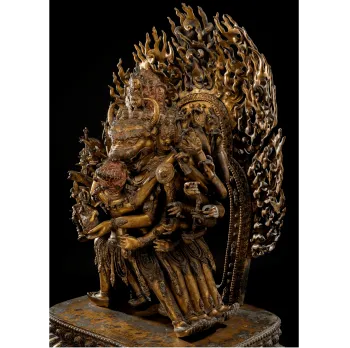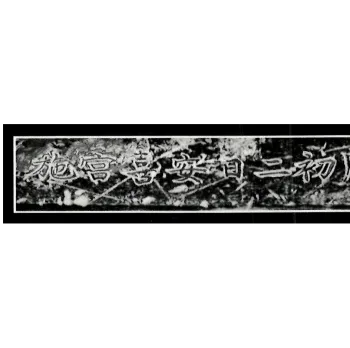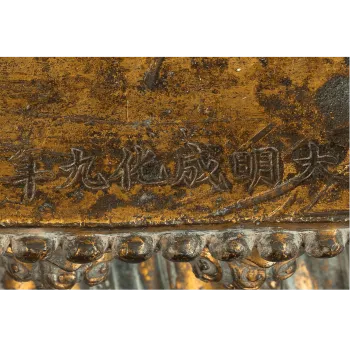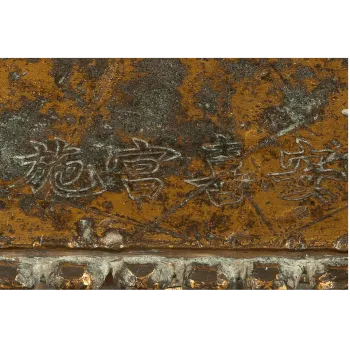Chinese Imperial Bronze Figure, Commissioned for an Emperor's Birthday
By:
The Value
On
01/06/2021Reading time:
0 min
Summary:
German Auction House Nagel to Make a Strong Comeback with a Chinese Imperial Bronze Figure, Commissioned for an Emperor's Birthday 500 Years Ago
An imperial gilt-bronze figure of Vajrabhairava
China, Ming dynasty, Chenghua period (1464-1487)
Marked and dated “daming chenghua jiu nian shiyi yue chu’er ri anxigong shi”
Corresponding to the second day of the 11th lunar month, the ninth year of Emperor Chenghua’s reign, 1473
Height: 92 cm
Weight: Figure: 94 kg, Base: 43 kg, Mandorla: 32 kg
Provenance:
Gumpel Collection, Paris, sold Drouot, November 24, 1904, lot 469
Alan Hartman New York, 1975
Important European private collection
Estimate: €1,000,000 - 1,500,000
Last August, German auction house Nagel Auktionen welcomed its new management. At the helm of its new CEO Uwe Jourdan, Head of the Asian Art Department Michael Trautmann and the three children of the auction house’s former owner, Robin Straub. The German auction house is presenting its first 2021 marquee sale to unfold its new chapter as Nagel marches into its 100th anniversary.
Leading the upcoming Fine Asian Art sale in June is a rare Chinese imperial gilt-bronze figure of Vajrabhairava. The monumental Buddhism figure dating back to 1473 was a gift to Emperor Chenghua 26th birthday in the ninth year of the Ming dynasty. The figure stands at a height of 92 cm tall.
Estimated at €1m to €1.5m (US$1.18m - US$1.76m), the bronze figure’s last auction was more than a century ago. It is truly a rare find across both museum collections and those in private hands, with only two other known examples of its kind existing.
The Inseparable Imperial Link
An extremely rare inscription running along the surface of the lotus pedestal gives us a clue to exactly when the bronze figure was cast. From right to left it reads “daming chenghua jiu nian shiyi yue chu’er ri anxigong shi (大明成化九年十一月初二日安喜宮施).”
The first half of the inscription translates to “the second day of the 11th lunar month, the ninth year of Emperor Chenghua’s reign,” corresponding to 1473. A direct imperial link between the Ming court and the present figure lies in the second half of the inscription. The “anxigong shi” part specifies that the bronze figure was bestowed by the Anxi Palace, in which Lady Wan Guifei, the most loved imperial consorts of Emperor Chenghua later occupied.
Currently in the collection of Shanghai Museum is a silk embroidery of Buddha from the Anxi Palace, which bears the inscription of the exact date of the present figure, but in the seventh year of Chenghua reign (1471). It was identified by the experts of the museum that it was commissioned by an imperial consort as a gift for Emperor Chenghua’s birthday.
With the two artefacts being only two years apart, it is possible that the figure on offer was created in the name of the same imperial consort, also for the occasion of Emperor Chenghua’s birthday as a blessing.
.png)

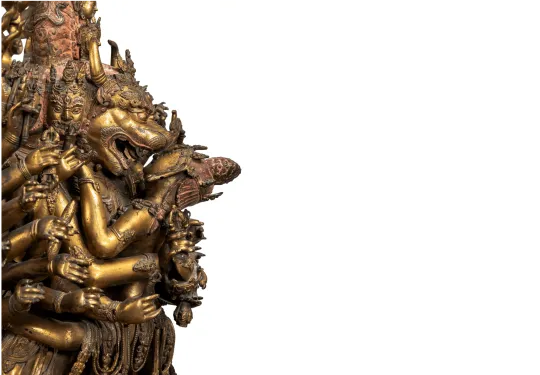
Vajrabhairava as a Powerful, Angry Manifestation of Manjushri
Vajrabhairava is one of the revered meditation deities of the Gelug lineage. It is the most formidable deity and also known as Yamantaka, “the destroyer of death.” It is an angry manifestation of Manjushri, the bodhisattva of Wisdom.
The principal buffalo-head with a ferocious expression, bulging eyes and flaming brows in meticulous detail symbolizes the center of the universe. The wrathful emanation also imparts a sense of command while signifying the victory of wisdom over the cycle of birth, death, and rebirth.
It is also flanked and surmounted by eight additional heads, including that of Manjushri, which is set against the red painted flaming hairdo, embracing the iconographic elements adopted by the Gelug tradition. Each of the heads represents such elements of one’s power of enlightenment needed to confront death, such as rage, authority, and sedateness. Radiating around Vajrabhairava’s torso, the 34 arms each holds the ritual implements, weapons and mudras. Together with his body, speech, and mind, they represent the 37 limbs of enlightenment.
His legs would have trampled upon various creatures - though presently missing, such as birds, animals, and subdued gods to convey Vajrabhairava’s conquest over all physical realms of existence, including the constant cycle of birth and death, passions, desires and fears.
Standing 92 cm in height, the figure of Vajrabhairava in militant posture, his consort Vajravetali flinging her left leg around his body, her hands holding a kapala and chopper, backed by a large flaming aureole.
As early as the Yuan dynasty (1279-1368), a majority of imperial Buddhist craftsmen working in Beijing were Nepalese and Tibetan, led by the imperially-sponsored atelier, the esteemed Nepalese artisan Aniko (1244-1306). While the hallmarks of Newari stylistic preferences were largely retained then and through the subsequent Ming dynasty (1368-1644), as more local Chinese artisans had replaced the Newari craftsmen over time, the iconographic parameters slowly evolved, as shown in the present figure.
.png)

